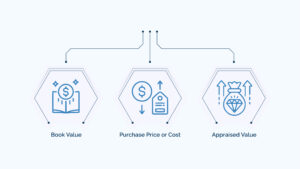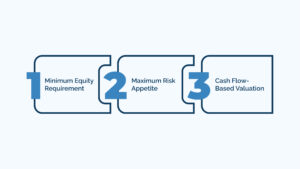You’ve done everything right. Paperwork in order, credit score polished, confidence high. Then the lender calls with bad news: application denied. The reason is a single figure buried deep in your file: the Loan to Value ratio (LTV).
Lenders treat LTV as a make-or-break measure of risk. The higher it is, the more cautious they become. A ratio just a few points off can turn approval into rejection, or leave you with higher rates and tougher terms, even if your credit history is spotless.
That’s why, before you apply for your next loan, understanding LTV is essential. In this blog, we will discuss what LTV means, how to calculate it accurately, and strategies to improve your ratio. Understanding this figure can strengthen your financing position, improve loan terms, and support long-term financial stability.
Important Takeaways
|
What Is Loan-to-Value (LTV) Ratio?
The Loan-to-Value (LTV) ratio measures the size of your loan compared to the appraised value of the property you’re financing. It’s shown as a percentage and helps lenders understand the level of risk they take on when approving a loan.
Lenders use the LTV ratio to decide loan terms and whether to approve the loan at all. A lower LTV means you’re borrowing less relative to the property’s value, which typically makes lenders more comfortable. A higher LTV indicates higher risk, which could lead to tighter terms or higher interest rates.
Factors that influence your LTV ratio include:
- Loan amount: The total funds you borrow
- Property value: The appraised worth of the property
- Type of loan: Different loans have varying LTV limits and criteria
Understanding these factors helps you approach financing with confidence and clarity.
What Does Loan-to-Value (LTV) Measure?

Understanding the value lenders use to calculate Loan-to-Value ratios matters, especially in commercial lending. Lenders rely on specific types of asset values to decide how much credit to extend. Generally, there are three main ways this value is determined:
Book Value
This is the value recorded on a company’s balance sheet. For example, when calculating credit based on accounts receivable (A/R), lenders often start with the book value as a reference.
However, for fixed assets like machinery or buildings, book value can be misleading since it accounts for depreciation, an accounting adjustment that doesn’t always reflect the asset’s real market value.
Purchase Price or Cost
When financing new equipment or property, lenders may use the purchase price as a straightforward measure of value. This works well when there is a clear invoice or transaction price. But if the asset is used or already owned, the purchase price doesn’t capture its current market value, so lenders look elsewhere.
Appraised Value
Appraisals provide an independent expert’s estimate of an asset’s worth. Commercial real estate and equipment often require appraisals to assess actual market value and identify any potential risks. Equipment appraisals offer three value estimates:
- Fair Market Value (FMV): The expected price if the asset sells in a typical market with multiple informed buyers.
- Orderly Liquidation Value (OLV): The value of the asset must be sold relatively quickly, but with some time to find buyers.
- Forced Liquidation Value (FLV): The lowest expected price if the asset is sold rapidly, often under distressed conditions.
When lenders set limits like 75% LTV, knowing whether that percentage applies to FMV, OLV, or FLV is crucial. A clear understanding among loan officers, risk managers, and borrowers ensures everyone has aligned expectations about the financing terms.
How Is Loan-to-Value (LTV) Calculated?

The Loan-to-Value ratio is calculated using a simple formula:
| LTV % = (Loan Amount ÷ Asset Value) × 100 |
However, the calculation can vary depending on the context and the lender’s approach. Here are a few practical scenarios illustrating how LTV may be determined:
Minimum Equity Requirement
In residential real estate, lenders often require borrowers to contribute a minimum equity portion toward the purchase price.
For example, if a lender mandates a 5% down payment, the maximum LTV allowed would be 95%. This is calculated as 100% minus the 5% equity, reflecting the highest loan proportion relative to the property value.
Maximum Risk Appetite
For commercial financing, such as loans secured against manufacturing equipment, lenders usually maintain a buffer to protect against depreciation or resale risk.
If the institution expects it could sell the property at a 25% discount, it might set a maximum LTV of 75%. This approach ensures the loan amount stays below the asset’s anticipated liquidation value.
Cash Flow-Based Valuation
In commercial mortgage lending, the loan amount is frequently linked to the property’s expected cash flow. Analysts estimate the future net operating income (NOI) generated by tenants and discount it back to its present value using an implied interest rate and debt service requirements.
The resulting present value represents the maximum loan the lender is willing to offer. Dividing this loan amount by the property’s appraised value and multiplying by 100 produces the LTV percentage.
These methods highlight how LTV serves as a flexible tool that lenders adapt based on asset type, risk tolerance, and repayment capacity.
Importance of Loan to Value Ratio
The Loan-to-Value ratio shapes lending decisions by influencing risk levels, borrower commitment, and the likelihood of approval.
Protecting Against Potential Losses
Lenders maintain a gap between the loan amount and the asset’s value to limit loss if repayment fails. This margin ensures recovery through asset liquidation, even in challenging markets.
Demonstrating Borrower Commitment
Borrowers who invest personal funds are more likely to meet repayment obligations. Covering the full asset value can weaken this incentive, increasing potential risk for lenders.
Determining Loan Approval Odds
Lower LTV ratios often secure faster approvals, better rates, and more flexible terms. Higher ratios may trigger stricter conditions or loan rejections.
The table below illustrates typical commercial real estate lender preferences:
|
LTV Ratio |
Likelihood of Loan Approval |
|
Up to 70% |
High |
|
70% to 80% |
Moderate |
|
Above 80% |
Low |
How Market Conditions Influence Loan-to-Value (LTV) Ratios
External economic and competitive factors can shift how lenders set and adjust LTV limits over time.
Responding to Competitive Pressures
Rising competition from banks, private lenders, and fintech firms can lead to more flexible LTV thresholds as institutions compete to attract borrowers.
Adjusting for Economic Shifts
Changes in interest rates, inflation, and market stability influence lender risk tolerance. Uncertain conditions often result in tighter LTV requirements.
Balancing Risk with Opportunity
Lenders continuously review policies to remain competitive while protecting against loan losses, ensuring LTV limits align with both market conditions and internal risk strategies.
Strategies to Improve Your LTV Ratio
Reducing your loan-to-value ratio can strengthen your loan application and help secure better financing terms. Here are some effective strategies to consider:
Pay a Larger Down Payment
Increasing the initial cash you put toward the purchase lowers the loan amount needed, directly reducing your LTV ratio and signaling financial commitment to lenders.
Increase Property Value Before Refinancin
Making improvements or renovations that boost your property’s market value can improve the ratio when you refinance, allowing you to access more favorable loan terms.
Negotiate a Smaller Loan Amount
Requesting a loan amount that is conservative relative to your property’s value reduces risk in the eyes of lenders, often resulting in smoother approvals and lower interest rates.
Applying these approaches can help you reduce your loan-to-value ratio, enhancing your financing options and positioning you better for successful loan approval.
Partner with Bluestone to Secure Fast, Reliable, & High-Certainty Lending Solutions

At Bluestone, our direct lending model, fast approvals, and transparent process ensure certainty of execution and a streamlined experience for every borrower.
Why Partner with Bluestone:
- Direct Access to Underwriting: Work with our in-house team for quick, reliable decisions.
- Speed Matters: Receive pre-approvals or term sheets within 24 hours, with closings possible in as little as 72 hours.
- Broker Protection: Benefit from transparent borrower fees and competitive broker compensation, paid after closing.
- Low Fees, High Certainty: Enjoy competitive rates with minimal underwriting and servicing costs.
- Expanded Market Reach: Connect with a network of serious borrowers ready to close.
- Higher Loan Quality: Rely on thorough underwriting and risk assessment to help reduce defaults.
Take the next step toward better financing outcomes. Discuss a solution that fits your goals and strengthens your LTV position.